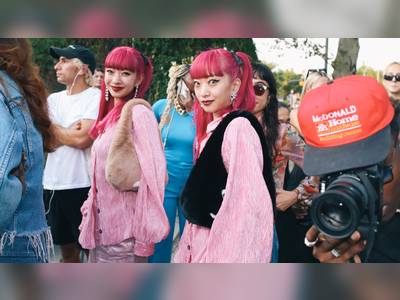It elevates you to another level.
When I visit an African market anywhere on this beautiful continent, I can easily become orgasmic just looking at African textiles.
The messages they convey are so deep they transcend many Western fictional romantic novels.
Their colour combinations can convey joy, fertility, status, wealth, renewal and passion — all on the same canvas.
For me, African fashion serves as one of the many statements in which we can re- appropriate African style from racist imagery, which insists on defining style and beauty through the narrow prism of a white standard of taste.
African design brilliantly advocates for social change, through the messaging on the textiles.
I try to support African independent labels, especially those which recognise that my African hips and bosom were never made to fit into a size 0. Rather, these assets were made for swaying and accentuating all my attributes from head to toe.
Gone Fall, writing for The Courier, in an article headed Fashion: Out of Africa ... the Breath of Inspiration, aptly says: “Very few people take the time to examine the cultural significance of African fashion. The presence of textiles in the African world dates back to Phoenician times.
“The colourful clothes of Africa first became a sign of wealth around 1000BC, during the period of the trans-Saharan trade, when traders used strip cloth as a form of currency. As a result, African textiles became known worldwide. During the European coastal trade in the 1400s, African fabrics where preferred by traders over fine European fabrics. The development of trade with the world established a ruling class in Africa, which in turn developed a need for luxury items.
“The quality and colour of African textiles became an expression of wealth and knowledge in society and it became an indication of social hierarchy. The development of kente cloth among the Ashanti illustrates how the use of cloth differentiates people by status, as fine kente cloth symbolises leadership.”
Why do white commentators feel the need to express what African taste is when they have no clue what these visual designs mean?
In many ways, African design seeks to ignite a cultural conversation by sometimes presenting provocative historical, social and sometimes sexual and sensual images that promote an educated exchange of ideas that may go beyond their comprehension.
There is a disingenuous charm about how white people describe what African style is.
The recent State of the Nation parade did not allow the so-called purveyors of taste and fashion to miss the opportunity to spread their delusions about what African style is.
In one Saturday paper, with the headline “Frock horror and fine feathers”, the columnist, commenting on the Speaker’s outfit, said: “Baleka Mbete had what looked like a brown paper bag on her head, complete with a shiny purple jacket and tie-dyed dress underneath.”
She went on, in her nauseating way: “For someone who appears to have her eye on more than the mere Speaker of the House job, perhaps she should employ a stylist or two.”
Ha! Maybe the columnist should stick to what she knows and comment only on uncomplicated Western fashion, a domain she is probably more familiar with.
Soon she’ll be describing the beautiful motifs on our African fabrics as ghosts from Halloween, and our flowing, regal African skirts as upside-down buckets.
As my friend pointed out, if it’s not Gavin Rajah or David Tlale’s imitation of something from the movie Grease, it’s not style.
It must be very frustrating for “commentators” on fashion and style, like Gwen Gill, to ascribe to African people their social status without having what they would define as recognisable labels.
African fashion is exerting an influence on catwalks globally.
From Tokyo to Harlem, from Rome and Paris to London, women are adorning themselves with bubas (tops), soras (wrap skirts) and geles (head ties).
African fashion has been embraced and adapted by Africans in the Diaspora.
Fashion events such as the Highbury Dunbar in London celebrate taste, design and culture in African clothing.
This further demonstrates the vibrant nature of African fashion. And many emerging African fashion designers are taking us back to our memories of who we once were as African people.
Many of their designs remind us to live harmoniously with each other.
Some are powerful and inspired, removing derogatory images and degrading slurs about African people that white society still secretly harbours and embraces.
There is a genre of African fashion designers all over the African continent, who are sending a message that African people are not so ignorant as to wear “brown paper bags” on their heads.
African fashion is often inspired by Africa’s historical impact on our society — it recalls the amazing human spirit of those who died fighting for what they believed.
It’s their memory that raises our consciousness, our dreams, and makes us the great African people we are.












